Hyper-Pseudo-Viscoelastic Model and Parameter Identification for Describing Tensile Recovery Stress–Strain Responses of Rubber Components in TBR
Abstract
:1. Introduction
2. Flow Chart of Numerical Calculation of Tensile Recovery Stress–Strain Responses
3. Experiments and Data Adjustment
3.1. Material Preparation
3.2. Quasi-Static Cyclic Stretching Experiments
3.3. Experimental Data Adjustment
4. Constitutive Models for Rubber Material
4.1. Hyperelastic Constitutive Model
4.2. The Ogden–Roxburgh Pseudoelastic Model
4.3. Viscoelastic Constitutive Model
5. Results and Discussion
5.1. Parameter Identification
5.2. Finite Element Analysis of the Tensile Recovery of Dumbbell-Shaped Specimen
6. Conclusions
- Nine rubber materials used in different components of TBR tires were subjected to tensile recovery experiments with different peak strain levels. An experimental data processing method was proposed to facilitate the parameter identification for the hyper-pseudo-viscoelastic model. The workflow of how to perform numerical calculation of tensile recovery stress–strain responses of rubber materials in tires was described.
- The Yeoh hyperelastic model, the Ogden–Roxburgh pseudoelastic model and the Prony series viscoelastic model were adopted together to describe the tensile recovery mechanical responses (loading curve, unloading curve and permanent set) of nine different rubber materials. The fitting result data are all in good agreement with the adjusted test data, and all the coefficients of determination exceeded 0.975. This method has certain universality.
- This study indicates that using the hyper-pseudo-viscoelastic constitutive model to predict the quasi-static cyclic loading of rubber materials is a feasible method. This work can guide the mechanical research of soft substances and rubber-like materials, and provides a support to design high-durability rubber products and high-performance tires.
- However, the introduction of complex nonlinear constitutive equations usually makes the finite element analysis have great convergence problems. In this work, the hyper-pseudo-viscoelastic constitutive model is only used for the deformation analysis of a simple dumbbell-shaped rubber specimen. For more complex products such as tires, the applicability of these models needs to be further explored.
Author Contributions
Funding
Data Availability Statement
Conflicts of Interest
References
- Suvanjumrat, C.; Rugsaj, R. Finite element modeling with embed rebar elements and steady state rolling analysis for rolling resistance test of pneumatic tire. In MATEC Web of Conferences; EDP Sciences: Les Ulis, France, 2017; p. 02004. [Google Scholar]
- Wang, W.; Yan, S.; Zhao, S. Experimental verification and finite element modeling of radial truck tire under static loading. J. Reinf. Plast. Compos. 2013, 32, 490–498. [Google Scholar] [CrossRef]
- Wei, L.; Liu, H.; Chen, H.; Zhao, Z. Finite element analysis of cross section of TBR tire. Mech. Adv. Mater. Struct. 2018, 27, 1509–1517. [Google Scholar] [CrossRef]
- Ge, Y.; Yan, Y.; Yan, X.; Meng, Z. Extending the tire dynamic model range of operating conditions based on finite element method. Adv. Mech. Eng. 2022, 14. [Google Scholar] [CrossRef]
- Rugsaj, R.; Suvanjumrat, C. Proper Radial Spokes of Non-Pneumatic Tire for Vertical Load Supporting by Finite Element Analysis. Int. J. Automot. Technol. 2019, 20, 801–812. [Google Scholar] [CrossRef]
- Wu, W.; Wen, S.; Wei, Y.; Ruan, L.; Li, F.; Cao, X.; Wang, Z.L.; Zhang, L. A volatile organic compound free unibody triboelectric nanogenerator and its application as a smart green track. Nano Energy 2023, 105, 108001. [Google Scholar] [CrossRef]
- Ghoreishy, M.H.R.; Alimardani, M.; Mehrabian, R.Z.; Gangali, S.T. Modeling the hyperviscoelastic behavior of a tire tread compound reinforced by silica and carbon black. J. Appl. Polym. Sci. 2013, 128, 1725–1731. [Google Scholar] [CrossRef]
- Bastiaan, J.M.; Khajepour, A. Finite Element Modeling of Tire with Validation Using Tensile and Frequency Response Testing. In ASME International Mechanical Engineering Congress and Exposition; American Society of Mechanical Engineers: New York, NY, USA, 2014; p. V012T015A016. [Google Scholar]
- Rafei, M.; Ghoreishy, M.H.R.; Naderi, G. Computer simulation of tire rolling resistance using finite element method: Effect of linear and nonlinear viscoelastic models. Proc. Inst. Mech. Eng. Part D J. Automob. Eng. 2018, 233, 2746–2760. [Google Scholar] [CrossRef]
- Veeramurthy, M.; Ju, J.; Thompson, L.L.; Summers, J.D. Optimisation of geometry and material properties of a non-pneumatic tyre for reducing rolling resistance. Int. J. Veh. Des. 2014, 66, 193–216. [Google Scholar] [CrossRef]
- Rosu, I.; Elias-Birembaux, H.L.; Lebon, F. Finite element modeling of an aircraft tire rolling on a steel drum: Experimental investigations and numerical simulations. Appl. Sci. 2018, 8, 593. [Google Scholar] [CrossRef] [Green Version]
- Mullins, L. Softening of rubber by deformation. Rubber Chem. Technol. 1969, 42, 339–362. [Google Scholar] [CrossRef]
- Hurtado, J.A.; Govindarajan, S.M. Advanced Simulation of Nonlinear Elastic Materials. In Proceedings of the Nafems World Congress 2009, Crete, Greece, 16–19 June 2009. [Google Scholar]
- Drozdov, A.D. Mullins’ effect in thermoplastic elastomers: Experiments and modeling. Mech. Res. Commun. 2009, 36, 437–443. [Google Scholar] [CrossRef]
- Huang, L.; Yang, X.; Gao, J. Pseudo-Elastic Analysis with Permanent Set in Carbon-Filled Rubber. Adv. Polym. Technol. 2019, 2019, 2369329. [Google Scholar] [CrossRef]
- Dalrymple, T.; Pürgstaller, A. Calibration of advanced material models for elastomers. In Constitutive Models for Rubber X; CRC Press: Boca Raton, FL, USA, 2017; pp. 503–508. [Google Scholar]
- Fazekas, B.; Goda, T.J. Constitutive modelling of rubbers: Mullins effect, residual strain, time-temperature dependence. Int. J. Mech. Sci. 2021, 210, 106735. [Google Scholar] [CrossRef]
- Ghoreishy, M.H.R.; Sourki, F.A. Development of a new combined numerical/experimental approach for the modeling of the nonlinear hyper-viscoelastic behavior of highly carbon black filled rubber compound. Polym. Test. 2018, 70, 135–143. [Google Scholar] [CrossRef]
- Kontou, E. Stress-softening effect of SBR/nanocomposites by a phenomenological Gent-Zener viscoelastic model. Meccanica 2018, 53, 2353–2362. [Google Scholar] [CrossRef]
- Fazekas, B.; Goda, T.J. New numerical stress solutions to calibrate hyper-visco-pseudo-elastic material models effectively. Mater. Des. 2020, 194, 108861. [Google Scholar] [CrossRef]
- He, H.; Zhang, Q.; Zhang, Y.; Chen, J.; Zhang, L.; Li, F. A comparative study of 85 hyperelastic constitutive models for both unfilled rubber and highly filled rubber nanocomposite material. Nano Mater. Sci. 2022, 4, 64–82. [Google Scholar] [CrossRef]
- Arruda, E.M.; Boyce, M.C. A three-dimensional constitutive model for the large stretch behavior of rubber elastic materials. J. Mech. Phys. Solids 1993, 41, 389–412. [Google Scholar] [CrossRef] [Green Version]
- Treloar, L. The elasticity of a network of long-chain molecules. I. Trans. Faraday Soc. 1943, 39, 36–41. [Google Scholar] [CrossRef]
- Mooney, M. A Theory of Large Elastic Deformation. J. Appl. Phys. 1940, 11, 582–592. [Google Scholar] [CrossRef]
- Ogden, R.W. Large deformation isotropic elasticity—On the correlation of theory and experiment for incompressible rubberlike solids. Proc. R. Soc. Lond. A Math. Phys. Sci. 1972, 326, 565–584. [Google Scholar] [CrossRef]
- Kilian, H.G.; Enderle, H.F.; Unseld, K. The use of the van der Waals model to elucidate universal aspects of structure-property relationships in simply extended dry and swollen rubbers. Colloid Polym. Sci. 1986, 264, 866–876. [Google Scholar] [CrossRef]
- Yeoh, O.H. Characterization of elastic properties of carbon-black-filled rubber vulcanizates. Rubber Chem. Technol. 1990, 63, 792–805. [Google Scholar] [CrossRef]
- Ogden, R.W.; Roxburgh, D.G. A pseudo-elastic model for the Mullins effect in filled rubber. Proc. R. Soc. Lond. Ser. A Math. Phys. Eng. Sci. 1999, 455, 2861–2877. [Google Scholar] [CrossRef]
- Mars, W. Evaluation of a Pseudo-Elastic Model for the Mullins Effect. Tire Sci. Technol. 2004, 32, 120–145. [Google Scholar] [CrossRef]
- Nutting, P. A new general law of deformation. J. Frankl. Inst. 1921, 191, 679–685. [Google Scholar] [CrossRef]
- Bernstein, B.; Kearsley, E.; Zapas, L. A study of stress relaxation with finite strain. Rubber Chem. Technol. 1965, 38, 76–89. [Google Scholar] [CrossRef]
- Bagley, R.; Torvik, P. Experimental verification of a generalized derivative uniaxial shear constitutive relation for the elastomer 3M-467. J. Acoust. Soc. Am. 1979, 65, S110. [Google Scholar] [CrossRef] [Green Version]
- Peng, M.; Xu, Z. Research on nonlinear constitutive relationship of permanent deformation in asphalt pavements. Sci. China Ser. G Phys. Mech. Astron. 2006, 49, 671–682. [Google Scholar] [CrossRef]
- Rubinstein, M.; Colby, R.H. Polymer Physics; Oxford University Press: New York, NY, USA, 2003; Volume 23. [Google Scholar]
- Skacel, P. Homepage of Hyperfit Software. Available online: http://www.hyperfit.wz.cz/ (accessed on 3 November 2022).
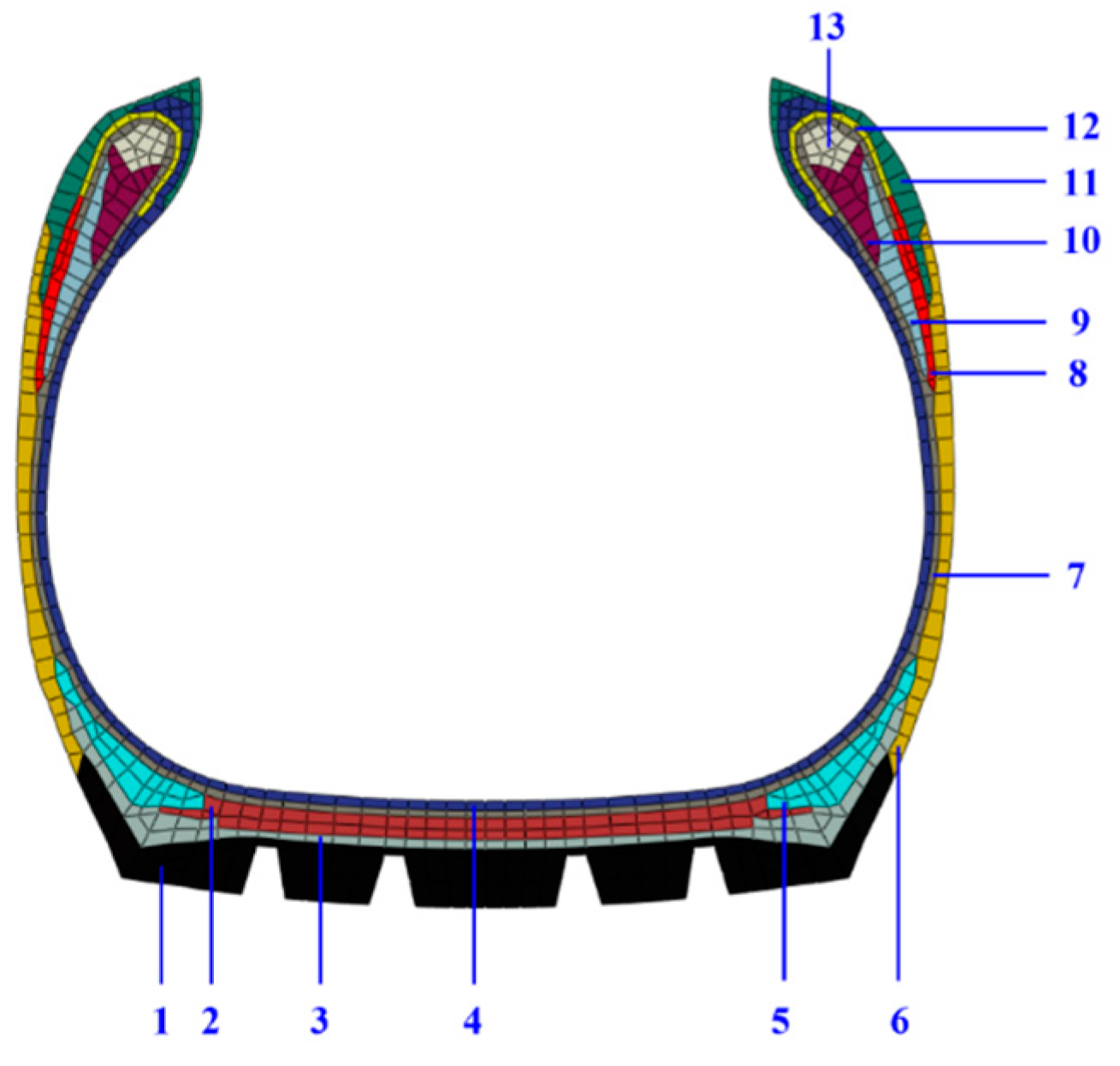

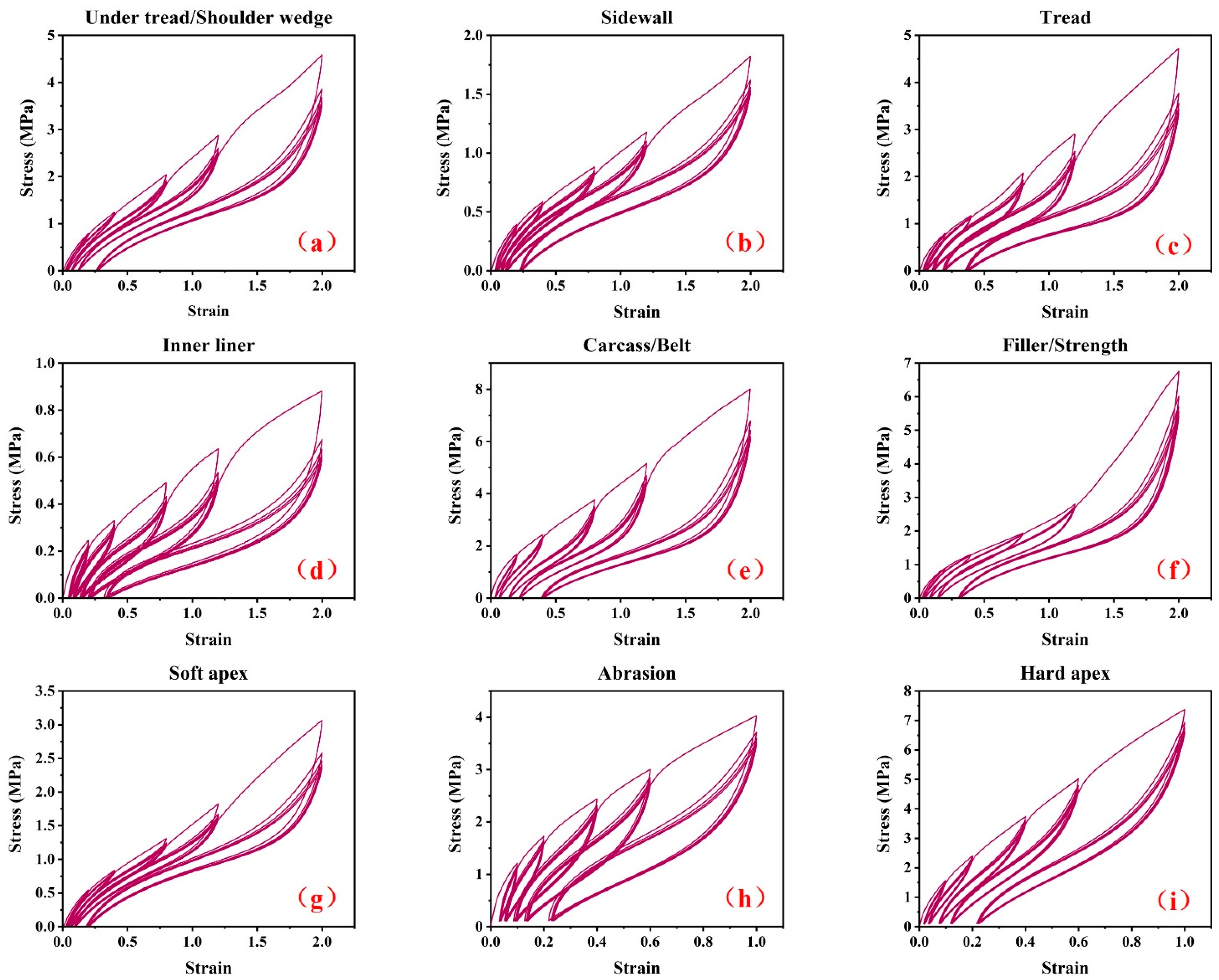
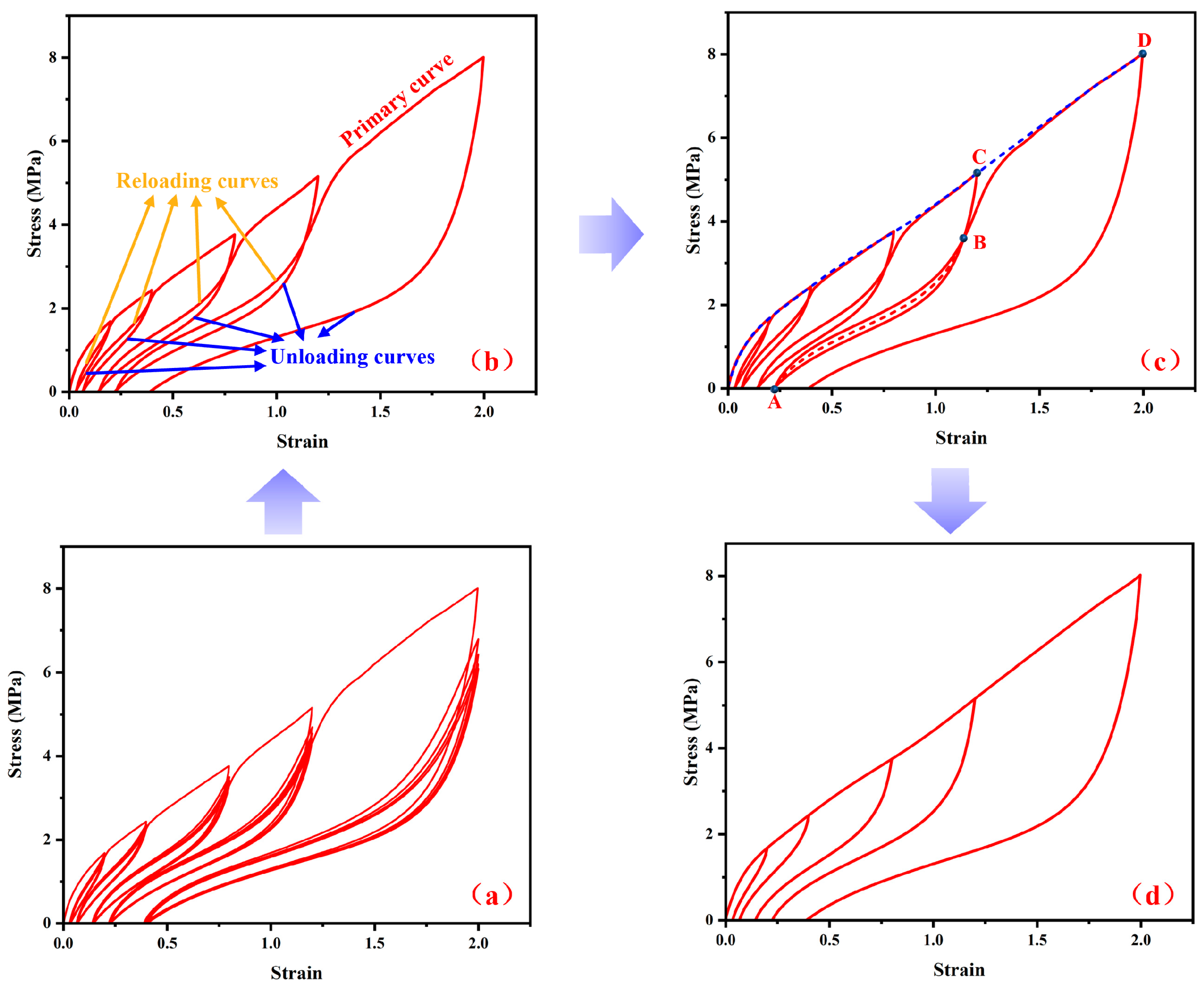

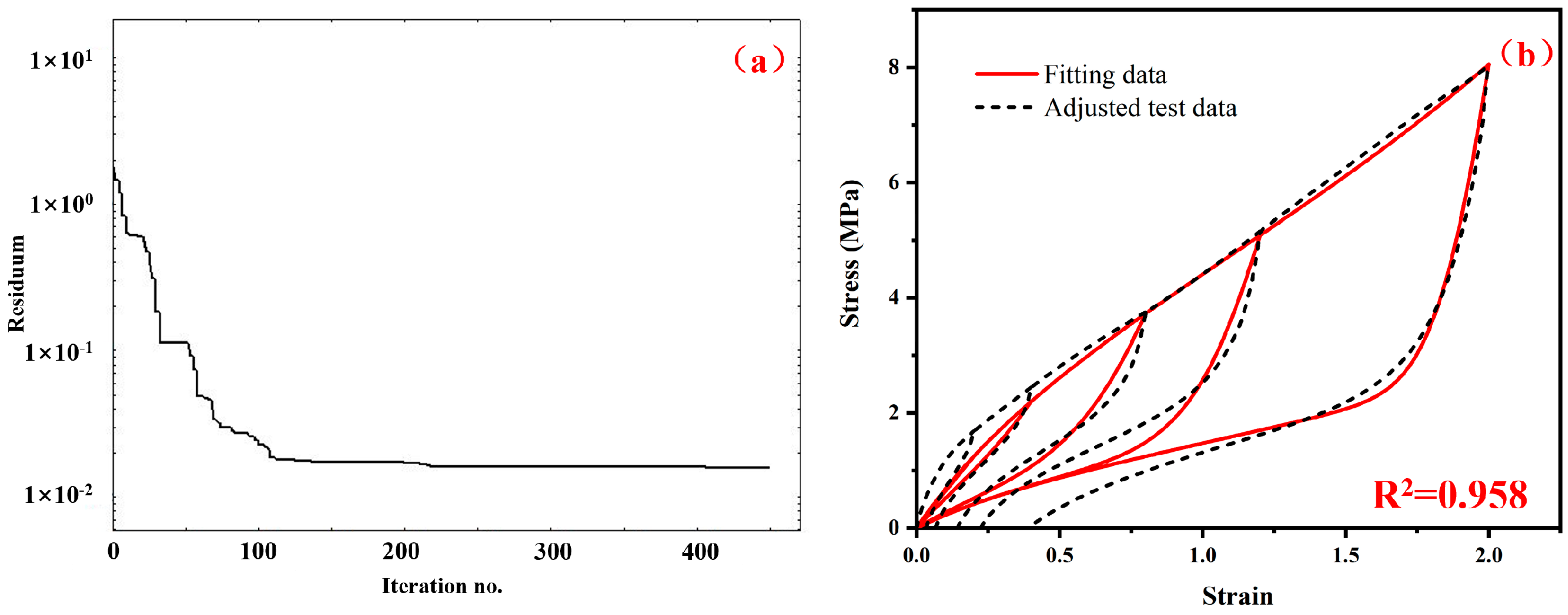


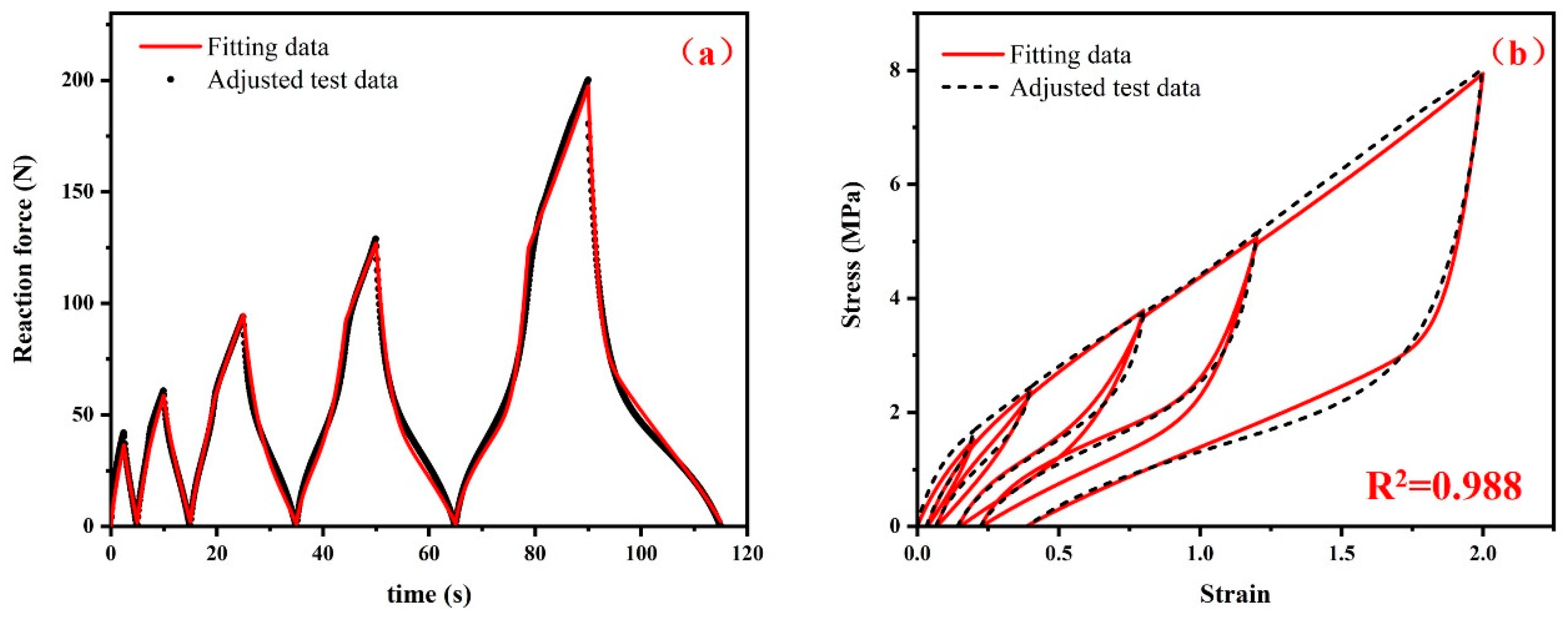



| Yeoh Hyperelastic Model | Ogden-Roxburgh Pseudoelastic Model | Prony Series Viscoelastic Model | |||||
|---|---|---|---|---|---|---|---|
| C10 | 1.2286 | r | 1.5022 | G1 | 0.20 | τ1 | 0.1 |
| G2 | 0.15 | τ2 | 1.0 | ||||
| C20 | 0.0055 | m | 1.3038 | ||||
| G3 | 0.08 | τ3 | 10.0 | ||||
| C30 | 0.0007 | β | 0.0605 | ||||
| G4 | 0.05 | τ4 | 100.0 | ||||
| Yeoh Hyperelastic Model | Ogden–Roxburgh Pseudoelastic Model | Prony Series Viscoelastic Model | |||||
|---|---|---|---|---|---|---|---|
| C10 | 0.9750 | r | 1.7874 | G1 | 0.0303 | τ1 | 0.1 |
| G2 | 0.3588 | τ2 | 1.0 | ||||
| C20 | 0.0156 | m | 0.7440 | ||||
| G3 | 0.0742 | τ3 | 10.0 | ||||
| C30 | 0.0001 | β | 0.0331 | ||||
| G4 | 0.0641 | τ4 | 100.0 | ||||
| The Peak Strain Level | Permanent Set of the Adjusted Test Data | Permanent Set of the Fitting Data | Relative Error |
|---|---|---|---|
| 20% | 0.033 | 0.037 | 12.1% |
| 40% | 0.066 | 0.069 | 4.5% |
| 80% | 0.143 | 0.150 | 4.9% |
| 120% | 0.224 | 0.231 | 3.1% |
| 200% | 0.387 | 0.392 | 1.3% |
Disclaimer/Publisher’s Note: The statements, opinions and data contained in all publications are solely those of the individual author(s) and contributor(s) and not of MDPI and/or the editor(s). MDPI and/or the editor(s) disclaim responsibility for any injury to people or property resulting from any ideas, methods, instructions or products referred to in the content. |
© 2022 by the authors. Licensee MDPI, Basel, Switzerland. This article is an open access article distributed under the terms and conditions of the Creative Commons Attribution (CC BY) license (https://creativecommons.org/licenses/by/4.0/).
Share and Cite
Pan, G.; Chen, M.; Wang, Y.; Zhang, J.; Liu, L.; Zhang, L.; Li, F. Hyper-Pseudo-Viscoelastic Model and Parameter Identification for Describing Tensile Recovery Stress–Strain Responses of Rubber Components in TBR. Polymers 2023, 15, 76. https://doi.org/10.3390/polym15010076
Pan G, Chen M, Wang Y, Zhang J, Liu L, Zhang L, Li F. Hyper-Pseudo-Viscoelastic Model and Parameter Identification for Describing Tensile Recovery Stress–Strain Responses of Rubber Components in TBR. Polymers. 2023; 15(1):76. https://doi.org/10.3390/polym15010076
Chicago/Turabian StylePan, Gao, Meimei Chen, Yao Wang, Jichuan Zhang, Li Liu, Liqun Zhang, and Fanzhu Li. 2023. "Hyper-Pseudo-Viscoelastic Model and Parameter Identification for Describing Tensile Recovery Stress–Strain Responses of Rubber Components in TBR" Polymers 15, no. 1: 76. https://doi.org/10.3390/polym15010076
APA StylePan, G., Chen, M., Wang, Y., Zhang, J., Liu, L., Zhang, L., & Li, F. (2023). Hyper-Pseudo-Viscoelastic Model and Parameter Identification for Describing Tensile Recovery Stress–Strain Responses of Rubber Components in TBR. Polymers, 15(1), 76. https://doi.org/10.3390/polym15010076








